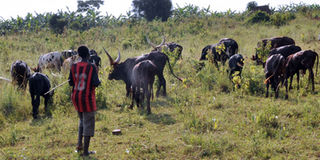Government to assess agriculture insurance for funding

Herders graze cattle in the Southern district of Isingiro, one of the drought prone areas in Uganda. Photo by Eronie Kamukama.
What you need to know:
- Despite the fact that the agriculture insurance scheme is promising, it still faces challenges. It is difficult to understand insurance, partly because farmers are semi-illiterate.
- Daily Monitor’s Eronie Kamukama elaborates on its performance.
The future of the Uganda Agricultural Insurance Scheme (UIAS) hangs in balance two years after it was piloted.
The scheme offering a premium subsidy was introduced by government to hedge farmers against agriculture risks/natural disasters such as floods, drought or fires.
“Government has put aside Shs5b and we anticipate this year that we are going to use up all of it. That is why we are trying to look for alternative ways that in the event that government’s contribution gets used up, then what happens to farmers who join at that point?” Agro Consortium officer Mr John Makosya says. The agro consortium is already engaging development agencies for support to ensure the scheme is sustainable.
Budget allocation
Each year since the financial year 2016/17, government has been allocating Shs5b to the scheme. Commenting on whether government will support future funding should current finances run out, permanent secretary in ministry of finance, Mr Keith Muhakanizi, confirmed that the consortium will receive money after an assessment is done.
“We shall evaluate and give them more. We have no problem with the insurance and we shall give more as per the probation by Parliament,” Mr Muhakanizi said.
It took the Agro-consortium three to four years to insure 5,000 farmers but since the introduction of the agricultural insurance scheme two years ago, the consortium is closing in on 70,000 farmers. Government had set a target of 80,000 farmers in five years but as at the end of June 2018, the consortium had insured slightly over 64,000 farmers and there is anticipation that the number will grow.
In its latest update, the consortium says the quick uptake reflects a growing appreciation for insurance given the effects of climate change.
“We visited an area in June and we knew it had been a good season as the rains were there. But the rain was too much and fields flooded. Even when it should have been good, people suffered loss. In light of climate change, there is no way to tell what seasons will be successful,” Mr Makosya says.
Additionally, the subsidy has brought down the cost of insurance.
Under the premium subsidy administered by Uganda Insurers Association for small holder farmers, government pays 50 per cent of the premiums and 30 per cent for large scale farmers. For farmers in disaster prone areas such as Isingiro, government pays 80 per cent of the premium.
Claims
Claims paid out, the consortium reports claims were about Shs4b.
“That is including what has been paid out and what we are due to pay out and the number of farmers who have so far been compensated could be about over 1,000,” Mr Makosya says.
About 78 per cent of the claims were compensated for drought.
Despite the fact that the scheme is promising, it still faces challenges. It is difficult to understand insurance, partly because farmers are semi-illiterate.
More so, being able to create awareness around the scheme requires resources. The consortium is not only low on funds but also has insufficient technical capacity to provide insurance services.
Expectations
Ms Faith Ekudu, Uganda Insurers Association publicist, says the programme, which is still in pilot, will be opened up to the country with the hope that it will have covered 100,000 farmers by the end of financial year 2018/19.
Growth
Amount. The Agriculture Insurance Scheme has grown to Shs4.5b in terms of premiums, with actual utilisation from the government programmes standing at Shs1.5b, according to the Agro Consortium, which brings together 10 local insurers
Challenges. A host of structural challenges in particular farm inputs being used, lack of well researched data on yields and numerous taxes have stood in the way of wide uptake of insurance cover by farmers.




